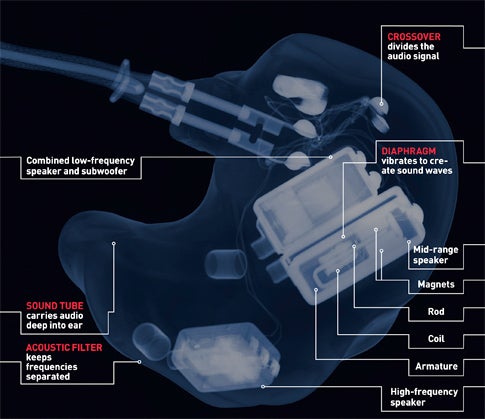How It Works: The Littlest Subwoofer
Ultimate Ears UE 11 Pro custom earphones pack in four separate speakers—including a subwoofer—to create sound as realistic as if you were hearing it live

We may earn revenue from the products available on this page and participate in affiliate programs. Learn more ›
Sacrificing sound quality for size was clearly not on the agenda when Ultimate Ears set out to create these top-of-the-line buds.
How to Deliver Pristine Sound
1. Separate the Signal
A circuit called a crossover divides the audio signal into different frequency ranges and routes each batch to one of four speakers in the earphone.
2. Activate the Speaker
The signal from the crossover enters a speaker and flows into a tiny copper coil, which responds with faint electromagnetic vibrations. Nearby, a small strip of metal, or armature, balances between the fields created by two magnets. The vibrations disrupt this magnetic field, causing the magnetized armature to pivot.
3. Move the Air
When the armature moves, it pushes a small rod connected to a diaphragm, which in turn pushes the surrounding air and generates sound waves.
4. Deliver the Sound
One sound tube carries the high frequencies while another handles the mids and the lows. Mixing treble and bass in your ear instead of in the headphones, as other earbuds do, makes music sound less like you’re hearing it inside a phone booth and more as it would in the hall where it was recorded. Acoustic filters prevent interference between the high and low frequencies inside the sound tubes.
- Size: Custom-fit
- Frequency Range: 10 Hz–16,500 Hz
- Price: $1,150
- Info: ultimateears.com
More How It Works:
- A hybrid with motors in the wheels
- The toy dinosaur that thinks for itself
- A lightweight, fuel-sipping jet engine
- A pill camera that shoots movies of your gut
- An HD camcorder that steadies shaky hands
- A [laser cannon that melts tanks from the air
- Flash memory that can take a dropkick
- A satellite that can photograph home plate from 425 miles up